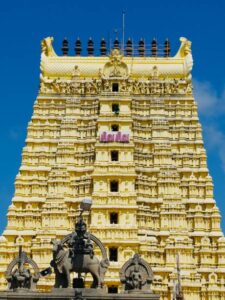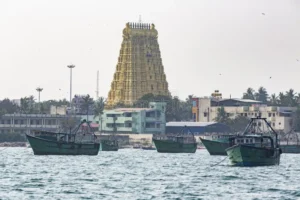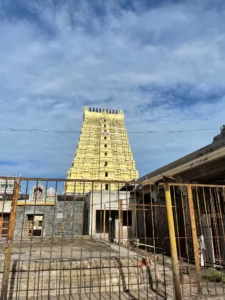
Table of Contents
Rameshwaram

Ancient temple tower against blue sky background.
Rameshwaram, a sacred pilgrimage site in Tamil Nadu, holds immense spiritual significance in Hinduism. Nestled on Pamban Island, it is revered as one of the Char Dham destinations and is closely associated with Lord Rama’s journey in the Ramayana. The majestic Ramanathaswamy Temple, known for its intricate Dravidian architecture and long pillared corridors, houses one of the twelve Jyotirlingas of Lord Shiva.
Pilgrims take a holy dip in the 22 theerthams (sacred water tanks) within the temple premises, believing it purifies the soul. The stunning Pamban Bridge, serene beaches, and Dhanushkodi’s mystical ruins add to its spiritual charm. Devotees also visit the Five-faced Hanuman Temple, home to floating stones believed to be part of Rama’s bridge to Lanka.
Rameshwaram’s tranquil ambiance, religious rituals, and breathtaking landscapes make it a divine destination for seekers of peace, devotion, and enlightenment. It offers a unique blend of spirituality, history, and natural beauty.
Mythological and Religious Significance
Rameshwaram holds a prominent place in Hindu mythology and is deeply associated with the epic Ramayana. According to legend, after rescuing Goddess Sita from Lanka, Lord Rama wished to atone for the sin of killing Ravana, who was both a Brahmin and a devout follower of Lord Shiva. To seek purification, he decided to worship Lord Shiva at Rameshwaram. However, he required a Shiva Linga for the rituals. Lord Hanuman was sent to bring a Shiva Linga from Mount Kailash, but as he was delayed, Goddess Sita sculpted a lingam out of sand, known as the Ramalingam. This sacred lingam remains enshrined in the Ramanathaswamy Temple and continues to be the focal point of devotion for millions of devotees.
Another fascinating aspect of Rameshwaram’s mythology is the construction of the Ram Setu, also known as Adam’s Bridge. This legendary bridge is said to have been built by Lord Rama and his army of Vanaras, led by Sugriva and Hanuman, to reach Lanka. According to the Ramayana, the bridge was made using floating stones, which bore the name of Lord Rama and miraculously remained afloat. Some of these stones can still be seen at the Five-Faced Hanuman Temple in Rameshwaram, attracting both religious pilgrims and researchers interested in ancient Indian engineering.
Rameshwaram is also one of the four Char Dham pilgrimage sites, along with Badrinath, Puri, and Dwarka. It is believed that a pilgrimage to Rameshwaram and performing sacred rituals, including a ritual bath in the 22 theerthams (holy water tanks) within the Ramanathaswamy Temple, can purify one’s soul and grant moksha (liberation from the cycle of rebirth). Many Hindus also perform Pitru Tarpan (ancestral rituals) here, as it is considered highly auspicious for offering prayers to deceased family members.
Additionally, the Gandhamadhana Parvatham, a hilltop shrine in Rameshwaram, houses Lord Rama’s footprints. It is believed that from this vantage point, Lord Rama surveyed the sea before devising the plan to cross over to Lanka. The site offers a panoramic view of the island and is another significant religious attraction.
With its strong connection to Lord Rama, Lord Shiva, and the Ramayana, Rameshwaram remains one of the most revered spiritual destinations in India. Pilgrims from across the country visit this sacred town, seeking divine blessings, purification, and a deeper connection with Hindu mythology and traditions.
Ramanathaswamy Temple: A Spiritual Marvel
The Ramanathaswamy Temple is the heart of Rameshwaram and one of the twelve Jyotirlingas of Lord Shiva. This magnificent temple is known for its:
- Dravidian architecture with towering gopurams
- Longest temple corridors in the world, adorned with intricately carved pillars
- Sacred 22 Theerthams (holy water tanks) where devotees take ritual baths to cleanse their sins
Pilgrims believe that a visit to Rameshwaram and performing the sacred rituals can grant them spiritual liberation (moksha).

Sacred Bathing Rituals: Theerthams of Rameshwaram
One of the most sacred aspects of the Rameshwaram pilgrimage is the ritualistic holy bath at the 22 Theerthams (holy water bodies) situated within the Sri Ramanathaswamy Temple complex. These Theerthams are believed to possess divine properties that purify the soul, cleanse past sins, and bestow spiritual enlightenment upon devotees.
Significance of Theerthams
The term “Theertham” refers to sacred water bodies that hold immense spiritual significance in Hindu tradition. According to legend, Lord Rama himself sanctified these waters after his victory over Ravana and sought absolution for any sins incurred during the war. The Skanda Purana and other ancient scriptures highlight the significance of these Theerthams in granting moksha (liberation) and washing away karma.
Each of the 22 Theerthams is associated with a unique mythological story and has distinct spiritual benefits. Pilgrims follow a ritualistic bathing sequence starting from Agnitheertham, located near the temple, before proceeding to the inner temple tanks.
The 22 Theerthams and Their Significance
- Agnitheertham – The most prominent Theertham, situated near the sea, where devotees take the first dip to begin their pilgrimage.
- Sethumadhava Theertham – Known for its ability to grant wisdom and intelligence.
- Gandhamadhana Theertham – Believed to increase mental clarity and peace.
- Kavacha Theertham – Provides protection from evil forces.
- Gavaya Theertham – Purifies the soul and removes all impurities.
- Nala Theertham – Named after Nala, the monkey engineer of the Ram Setu, and is said to bring success in endeavors.
- Neela Theertham – Promotes good health and well-being.
- Shanku Theertham – Associated with Lord Vishnu and bestows devotion.
- Chakra Theertham – Said to remove past sins and increase spiritual consciousness.
- Brahmahathi Vimochana Theertham – Offers relief from sins related to harming others.
- Surya Theertham – Provides strength and vitality.
- Chandra Theertham – Balances emotions and mind.
- Ganga Theertham – Equivalent to taking a dip in the Ganges, known for ultimate purification.
- Yamuna Theertham – Enhances spiritual devotion.
- Gaya Theertham – Helps in attaining ancestral blessings and liberation.
- Saraswathi Theertham – Enhances knowledge and learning.
- Siva Theertham – Dedicated to Lord Shiva, removing fears and illusions.
- Satyamirtha Theertham – Grants truthfulness and righteousness.
- Sarva Theertham – Known to cure ailments and bodily suffering.
- Kodi Theertham – Enhances self-discipline and spiritual practices.
- Mangal Theertham – Brings prosperity and happiness.
- Varuna Theertham – Provides blessings for a harmonious life.

Ritual Process of Bathing
The bathing ritual in Rameshwaram follows a prescribed order:
- Pilgrims first take a dip in Agnitheertham at the seashore.
- They then proceed to the temple to bathe in the remaining 21 Theerthams, each with a designated area within the complex.
- After completing the holy bath, devotees perform prayers and seek blessings at the Sri Ramanathaswamy temple.
- It is customary to complete the pilgrimage by offering worship to Lord Shiva inside the sanctum.
Spiritual Benefits of the Theerthams
- Cleansing of Sins: It is believed that taking a bath in all 22 Theerthams absolves one of past sins and karma.
- Physical & Mental Well-being: The mineral-rich waters are known for their therapeutic properties.
- Blessings for Moksha: Devotees pray for spiritual liberation and enlightenment.
- Ancestral Gratitude: Some Theerthams are linked to seeking blessings for one’s ancestors.
- Protection from Negative Energies: Ritual bathing is said to remove bad omens and negative influences.
Dhanushkodi: The Mystical Ghost Town
A visit to Rameshwaram is incomplete without exploring Dhanushkodi, a deserted town once destroyed by a cyclone in 1964. This eerie yet beautiful location is believed to be the place where Lord Rama marked the end of the Ram Setu with his bow (Dhanush). The stunning confluence of the Bay of Bengal and the Indian Ocean at Dhanushkodi is a mesmerizing sight for visitors.
Pamban Bridge: An Engineering Marvel
Connecting Rameshwaram to the mainland, Pamban Bridge is India’s first sea bridge and a masterpiece of engineering. The railway bridge, which opens up to allow ships to pass, offers breathtaking views of the turquoise waters, making it an attraction in itself.
Five-Faced Hanuman Temple and Floating Stones
The Five-Faced Hanuman Temple in Rameshwaram is another significant religious site. It houses floating stones, which are believed to be remnants of the Ram Setu bridge, adding to the mystical allure of the place. Devotees flock to this temple to seek Lord Hanuman’s blessings and witness this divine marvel.
Gandhamadhana Parvatham: A Divine Viewpoint
Gandhamadhana Parvatham is a hilltop temple dedicated to Lord Rama. It offers a panoramic view of Rameshwaram and the surrounding waters. The temple houses Lord Rama’s footprints, further enriching its religious significance.
A Blend of Spirituality and Natural Beauty
Beyond temples and mythological sites, Rameshwaram is also home to serene beaches and scenic landscapes. Agnitheertham Beach, located near the Ramanathaswamy Temple, is an important spot where pilgrims take a holy dip. The pristine Ariyaman Beach and Kurusadai Island provide opportunities for relaxation and exploring marine biodiversity.
How to Reach Rameshwaram
- By Air: The nearest airport is Madurai International Airport (170 km away), well-connected to major cities.
- By Train: Rameshwaram Railway Station is linked to cities like Chennai, Madurai, and Coimbatore.
- By Road: Frequent buses and private taxis operate from Tamil Nadu’s major cities to Rameshwaram.
Best Time to Visit
The ideal time to visit Rameshwaram is between October and April, when the weather is pleasant, cool, and suitable for temple visits, sightseeing, and spiritual activities. During these months, the temperature ranges between 20°C to 30°C, making it comfortable for pilgrims to explore the sacred sites, take part in religious rituals, and visit nearby attractions like Dhanushkodi, Pamban Bridge, and Agnitheertham Beach.

Seasonal Guide to Visiting Rameshwaram:
- Winter (October to February) – Best Time to Visit
- Weather: Cool and pleasant, with temperatures ranging from 20°C to 25°C.
- Why Visit: Ideal for temple visits, outdoor sightseeing, and beach exploration. The calm weather makes it easy to perform religious rituals like taking a dip in the 22 theerthams of Ramanathaswamy Temple.
- Festivals:
- Maha Shivaratri (February/March): A grand celebration in honor of Lord Shiva at Ramanathaswamy Temple.
- Thai Amavasai (January/February): A significant day for performing ancestral rituals and Pinda Daan at Agnitheertham.
- Summer (March to June) – Hot and Humid
- Weather: High temperatures ranging from 28°C to 40°C, with high humidity levels.
- Why Visit: Despite the heat, pilgrims continue to visit the temple. Mornings and evenings are more comfortable for temple darshan and sightseeing.
- Tip: If visiting during summer, carry light cotton clothing, sunscreen, sunglasses, and water to stay hydrated.
- Monsoon (July to September) – Rainy and Humid
- Weather: Heavy rainfall with occasional thunderstorms. Temperature ranges between 25°C to 30°C.
- Why Visit: While the rains add a mystical charm to the surroundings, heavy downpours can make travel difficult. The temple remains open, but outdoor activities may be limited.
- Tip: If traveling during monsoon, carry rain gear, waterproof bags, and plan for indoor temple visits.
Conclusion
Rameshwaram is not just a pilgrimage site but a destination that embodies spiritual energy, architectural grandeur, historical richness, and natural beauty. Every aspect of this sacred town—from the divine Ramanathaswamy Temple and its mystical 22 theerthams to the awe-inspiring Ram Setu and the serene shores of Agnitheertham—weaves a spiritual and cultural tapestry that captivates the heart of every pilgrim and traveler.
For those seeking religious fulfillment, Rameshwaram is one of the holiest places in Hinduism, offering opportunities for rituals, prayers, and penance. The presence of one of the twelve Jyotirlingas, the sacred bath at theerthams, and the historical connection to Lord Rama’s divine journey make it a powerful place for spiritual upliftment.
For history and mythology enthusiasts, Rameshwaram provides a living connection to the Ramayana, with sites like Dhanushkodi, Gandhamadhana Parvatham, and the Five-Faced Hanuman Temple narrating the ancient tales of Lord Rama and his epic battle against Ravana. The mysterious floating stones and the remnants of Ram Setu continue to intrigue historians and devotees alike.
Beyond its religious and historical importance, Rameshwaram is also a haven of scenic tranquility. The mesmerizing Pamban Bridge, the serene Ariyaman Beach, and the enchanting Kurusadai Island offer breathtaking views, marine wonders, and moments of peace away from the bustling crowds. The town’s peaceful environment makes it an ideal destination for those seeking meditation, self-reflection, and inner peace.
Rameshwaram Map
Follow More Article
